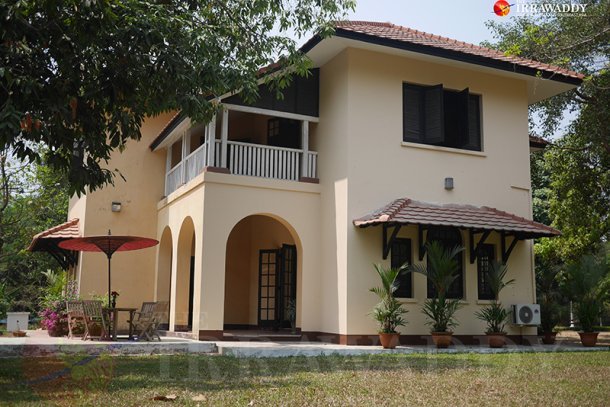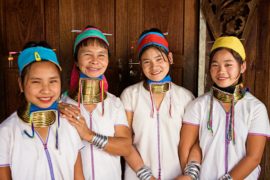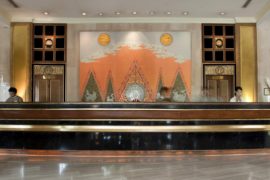RANGOON — Following decades of obscurity caused in some measure by his own humility and in large part by a regime attempting to rewrite history, intimate minutiae from the life and legacy of U Thant, one of Burma’s diplomatic treasures, are now on display in his Rangoon home.
The U Thant Exhibition showcases photographs, documents and recordings offering a glimpse into the life and times of U Thant, who served as the first Asian UN Secretary General after his years as secretary to Burma’s first Prime Minister U Nu.
“He was famous locally and internationally as UN secretary, but many people still don’t know about his work here as an educator, writer and a public servant,” said Shine Min Tun, a museum docent at the exhibition, which is open to the public every Saturday and Sunday throughout March. Shine Min Tun said that the show has received an average of 70 to 80 visitors every day that it was open.
The exhibition features 18 historic photographs of U Thant, displayed in the dining room of his former home. In the living room are more intimate photos of U Thant with his family. The upstairs has been outfitted with texts detailing his life and work in Burma and New York, where he moved to join the UN Security Council. Sixteen multimedia displays featuring his public speeches are also on view.
“I have always respected him,” said Sai Tikyi Mg, a 25-year-old visitor to the exhibition. “But when I arrived here I got to know all these details that I didn’t know before; I can see his thoughts and visions. If he were alive now, I would run to him and pay respect.”
Sai Tikyi Mg was among a number of young visitors to the museum; U Thant left Burma to work for the United Nations just a few years before Ne Win overthrew the government in a 1962 coup d’état.
“I think that he is more famous among the youth because of the U Thant Affair at Rangoon University,” said Sai Tikyi Mg, referring to the events following his death in November 1974. U Thant died of Lung cancer in New York, but his body was sent to Rangoon for burial. Just as tens of thousands of people turned out on the streets of what was then Burma’s capital to pay their respects, a group of students made off with his coffin and buried it on the former grounds of the Rangoon University Students’ Union.
A mausoleum was built on the site, and on Dec. 11 government troops burst into the campus, killed some of the students, retrieved the coffin and relocated it to the foot of Shwedagon Pagoda, where it still lies today.
“He was always in our hearts, whether his achievements were publicly praised or not,” Sai Tikyi Mg said.
Another young visitor, Aye Nandar Hlaing, 31, said she was excited to finally be able to visit the U Thant House, which had fallen into disrepair under government ownership until the Yangon Heritage Trust (YHT)—a preservation group helmed by U Thant’s grandson, Thant Myint-U—proposed renovating the building and converting it into the museum it is today.
“I believe we should visit U Thant’s House, he was UN Secretary General and very intellectual,” said Aye Nandar Hlaing, remarking that she was “very proud” and that Burma’s youth should strive to emulate the late diplomat’s achievements.
U Thant and his family lived at the colonial-style house on 31 Pan Wah Lane, Kamayut Township, from 1951 to 1957 while he served as secretary to then-Prime Minister U Nu. After serving as a permanent representative to the United Nations, U Thant was later appointed as the third UN Secretary General, and during his tenure from 1961 to 1971 he helped to defuse the Cuban Missile Crisis, which brought the United States and the Soviet Union to the brink of nuclear war. He also played a pivotal role in ending a civil war in the Congo.
When Thant Myint-U discovered his grandfather’s former home in a state of disrepair in 2012, he rounded up support from the government to establish the U Thant House Museum as a public resource honoring the man’s life and principles. A soft opening was held in April 2013, and a few small events have since been held there.
“This is meant as a start,” Thant Myint-U said of the new exhibition in an email to The Irrawaddy. “I would like the U Thant House to be a place that not only remembers his life and work, but also a place to discuss the issues that were important to him, like peace, sustainable development, and environmental protection. I don’t want it to be the kind of museum where people just come to look at things.”
Thant Myint-U has more ideas in store for turning the museum into a valuable community resource. He said he hopes to eventually host seminars and workshops, and eventually open a café, digital library and bookshop.
The current exhibition was made possible with assistance from the United Nations and the Indian government, as well as the YHT. The show is free and open to the public from 10am to 5pm every weekend in March, after which the museum will be closed for one month for further renovations.
Source: Irrawaddy







Comments are closed.